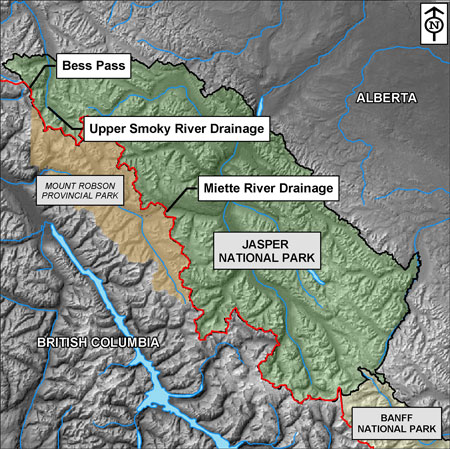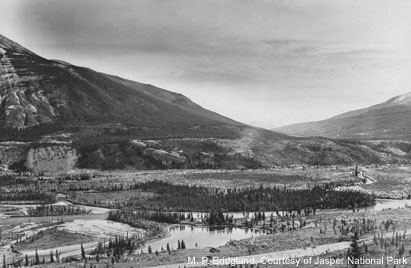Jasper National Park
 |
It’s getting hot out here: Climate, Fire, and Beetles in Jasper National Park
 |
Jasper quick beetle facts:
- In 2002, beetles appeared in the Miette Drainage near the West Gate.
What do you get when you mix decades of warming trends with fire suppression in Jasper National Park? In 1999, the annual insect and disease survey found mountain pine beetle along the Smoky River. Although mountain pine beetle does occur at low levels in the park, the beetles in the Smoky River area had likely immigrated from a beetle outbreak on the British Columbia side of Bess Pass. In the past, Jasper has been too cold for mountain pine beetle survival. However, studies show that warming trends over the past few decades have allowed beetles to move into higher elevation areas and more northerly regions that were once too cold for many beetles to survive. This, combined with the lack of fire in the park has set the stage for beetle outbreaks.
 |
Dr Allan Carroll explains how far the mountain pine beetle could potentially expand its range:
"The mountain pine beetle is currently in an epidemic across much of western Canada right now, and in fact it’s covering huge areas of the forest of central British Columbia. And it’s by observing that particular outbreak we’re noticing that the beetles are occurring in areas that are farther north, or higher in elevation than it has in the past. These areas are normally too cold for the mountain pine beetle. So this has stimulated us to ask the question: indeed, has there been a climate change? Has the climate change affected the amount of available forest for the mountain pine beetle and have they moved? This is where my research has gone. We’ve actually been assessing this through our modeling and research and indeed we have found that it’s true, that not only has the climate changed, but it’s improved for the mountain pine beetle and the beetles moved there so they’re able to respond very quickly. This has all happened in the last 30 years, so as the climate is anticipated to improve still further, we can anticipate the beetle itself to follow that improvement, so it’s capable of significant movement and is a real concern to us."
|
|
 In the absence of fire, pine trees become dominant over an 84 year period. © J.M. Rhemutulla and E.S. Higgs, University of Alberta, 2000 |
Currently, the population in the Smoky River is struggling to survive, as a result of high winter death rates due to woodpecker predation and cold weather. There has been no evidence of further immigration by beetles since 1999. Local beetle populations in the Smoky are expected to continue at current low levels, on scattered single trees or small groups of unhealthy trees. Due to the low resistance of many of the trees in the area, a small population may continue to persist for a number of years.
Not all mountain pine beetle populations are declining in Jasper National Park. In 2002, mountain pine beetle were found along Highway 16 in the Miette Watershed. The forest in the Miette River valley is in perfect condition for a beetle outbreak, as the lower slopes and valley bottom are covered with diseased, drought stressed, over - mature pine trees.
To see what tools the Mountain Parks are using to manage mountain pine beetle, click here.
1 hectare = 100 metres x 100 metres
1 hectare = 2.47 acres
1 hectare = Approximately 2 football fields (side by side)
100 hectares = 1 square kilometre
- Date modified :
